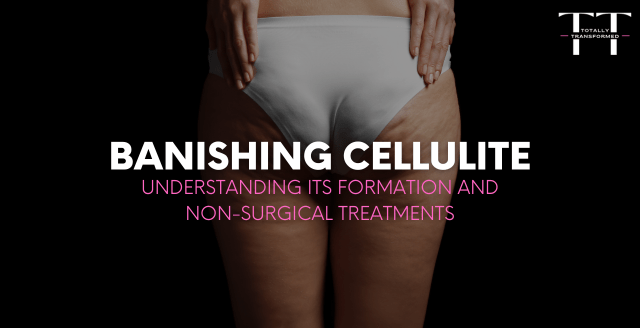Cellulite – it’s a word that sends shivers down the spines of many. Affecting individuals regardless of age, gender, or body type. Often misunderstood, cellulite is a common concern that can impact self-confidence and body image. However, armed with the right knowledge and treatment options, it’s possible to effectively reduce its appearance and regain confidence in your skin. In this blog post, we’ll jump into the formation of cellulite and explore non-surgical treatments that have shown promising results in combating this pesky condition.
Understanding Cellulite Formation:
Cellulite is the dimpled, lumpy appearance of skin, often likened to the texture of orange peel or cottage cheese. It typically develops in areas with underlying fat deposits, such as the thighs, buttocks, hips, and abdomen. Contrary to popular belief, cellulite isn’t solely related to excess weight; it can affect individuals of all body shapes and sizes.
The formation of cellulite is multifactorial, involving various physiological and structural factors:
- Connective tissue structure: The skin is connected to deeper tissues by fibrous bands called septae. In areas prone to cellulite, these septae can become rigid and inflexible over time. When fat cells enlarge and push against the skin, the rigid septae pull down on the skin’s surface, creating the characteristic dimpled appearance of cellulite.
- Fat accumulation: Cellulite typically occurs in areas with higher concentrations of fat cells. Areas such as the thighs, buttocks, hips, and abdomen. As fat cells expand due to factors like weight gain, genetics, or hormonal changes, they can protrude through the weakened connective tissue, exacerbating the appearance of cellulite.
- Decreased skin elasticity: Aging, hormonal fluctuations, and genetic predisposition can lead to a decline in skin elasticity. When the skin loses its firmness and resilience, cellulite becomes more noticeable. Diminished collagen and elastin production contribute to the sagging and uneven texture associated with cellulite.
- Poor circulation and lymphatic drainage: Impaired blood flow and lymphatic drainage can contribute to fluid retention and toxin buildup in the tissues. This can exacerbate inflammation and swelling, further compromising the appearance of cellulite. Additionally, sluggish circulation may hinder the delivery of nutrients and oxygen to the skin, impairing its overall health and resilience.
- Hormonal factors: Hormonal changes, such as those occurring during puberty, pregnancy, or menopause, can influence the development and severity of cellulite. Fluctuations in oestrogen levels, in particular, may affect fat distribution, collagen production, and blood vessel function, all of which play a role in cellulite formation.
Non-Surgical Treatments for Cellulite:
While complete eradication of cellulite may be challenging, there are a number of non-surgical treatments can effectively minimise its appearance and improve skin texture. Here are some popular options:
- Topical creams and lotions: Many over-the-counter creams and lotions claim to reduce cellulite by targeting fat cells, promoting collagen production, or improving circulation. Look for products containing ingredients like retinol, caffeine, and antioxidants, which may help tighten the skin and reduce dimpling.
- Radiofrequency (RF) therapy: RF treatments deliver energy waves to the deeper layers of the skin, stimulating collagen production and tightening the skin. This can help smooth out cellulite and improve skin texture over time. RF therapy is non-invasive and painless. We recommend a course of treatments delivered over multiple sessions for optimal results.
- Shockwave therapy: Also known as acoustic wave therapy, this treatment involves the delivery of high-energy acoustic waves to the affected areas. Breaking down fat cells and stimulating collagen production. Shockwave therapy is non-invasive and relatively painless. We recommend a course of treatments delivered over multiple sessions for optimal results.
Cellulite may be a common concern, but it doesn’t have to dictate your confidence or self-image. By understanding the factors contributing to its formation and exploring non-surgical treatment options, you can take proactive steps towards smoother, firmer skin. Whether you opt for topical creams, or advanced treatments like RF or laser therapy, consistency and patience are key to achieving noticeable improvements in cellulite appearance.
Remember, everyone’s journey is unique, so consult with a qualified professional




